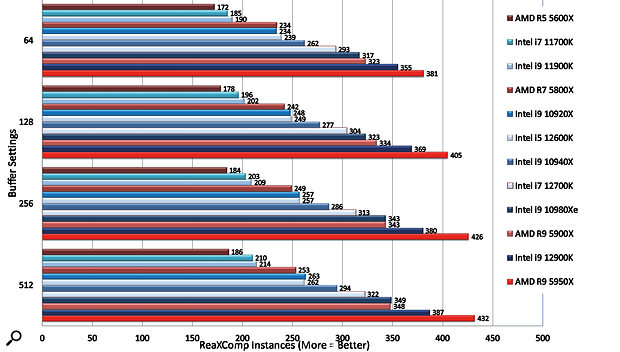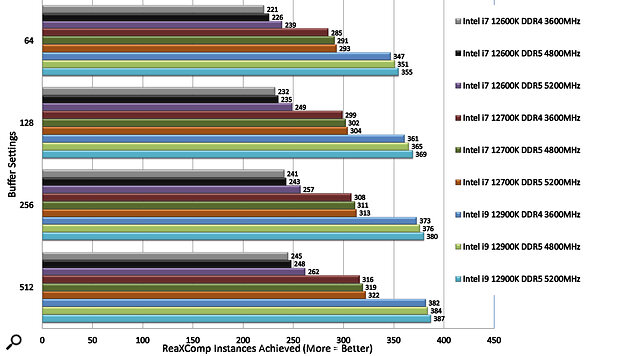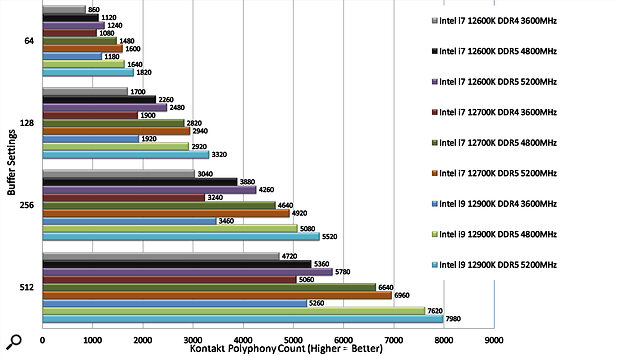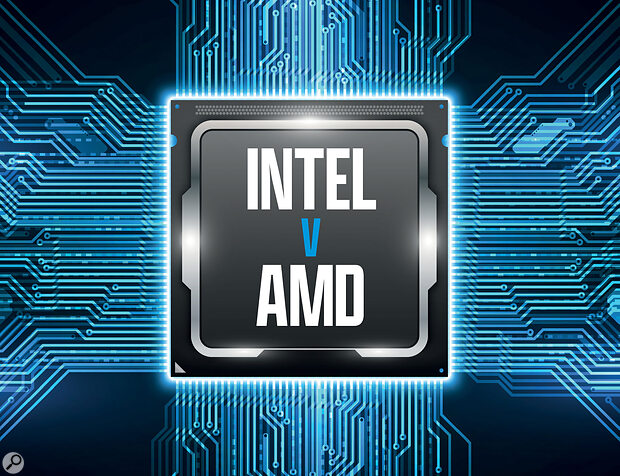Intel’s latest CPUs promise big performance gains. But can they topple AMD in our audio benchmarks?
Computers underpin most music production today, and at the heart of each computer is a CPU. While some audio producers’ computing needs are relatively modest, plenty of us need more power — but when you want to assess a chip’s capability for real‑world audio applications the headline specs tell you only part of the story. As well as the maximum single‑core speed and number of cores, factors include the price, power consumption, memory handling, heat, and the measurable real‑world performance for different use cases at various audio interface buffer settings. This article aims to help you understand what the latest crop of CPU chips are capable of when working with audio: how many signal processing or virtual instrument/sampler plug‑ins you can realistically run at a range of audio buffer settings before you run into problems.
I’ve included some charts which show how Intel’s new 12th‑generation (Alder Lake) chips compare with the previous series and AMD’s current range, as well as how RAM might influence the performance. But I’ll start by bringing you up to date on the main manufacturers’ progress since we last assessed CPU performance, in SOS August 2020: https://sosm.ag/core-wars-0820. I’ll then explain some other significant developments in the computing world, before discussing some useful ‘takeaways’ from our tests for anyone considering buying or building an audio machine in the near future.
Catching Up
If you read that previous article, you’ll recall that AMD were in a strong position. Although Intel had dominated the audio‑computer world for the best part of a decade, AMD’s 2000 series had already begun to level the playing field and by this time their well‑specified and affordable 3000 series had left Intel with no option but to bring their prices down. Meanwhile Apple’s decision to develop their own chips had further ramped up the pressure on Intel, and I predicted that we may be on the verge of another ‘CPU arms race’. So let’s quickly catch up on what’s happened since.
Early in 2021, Intel released their 11th‑generation (I’ll call it ‘gen’ from here) Core processor range, which met with a mixed reception. The Skylake desktop chip architecture was replaced with Cypress Cove‑based cores borrowed from the 10nm‑based solution already found in various laptop models. It was certainly a step in the right direction, delivering a significant improvement to single‑core performance; the fastest model offered a base speed of 3.5GHz and a maximum Turbo frequency of 5.3GHz. But new‑gen chips usually also benefit from a ‘process shrink’ (or ‘die shrink’; a physical scaling down of the semiconductors) and this wasn’t achieved. So the 10nm design had to be fitted into a 14nm‑chip package, and the performance increase came at the cost of relatively high power consumption and heat. And that limited the maximum number of cores...
For applications where single‑core speed is of paramount importance, then, the 11th‑gen chips held their own despite stiff competition. But where multicore processing is more important they proved less impressive. The top‑of‑the‑range Core i9 11900K, for example, had eight cores compared with the previous‑gen Core i9 10900K’s 10, and in several performance tests involving tasks that efficiently exploit all the available cores the 10900K scored better, hence Intel continuing to offer that chip.
AMD weren’t resting on their laurels. Their much higher core‑count chips had already proved suitable for audio workstations before their 5000‑series CPUs arrived at the end of 2020, several months before Intel’s 11th‑gen chips. AMD’s 5000 series showed that the company were able to remain a step ahead of Intel, in terms of both release schedule and CPU performance. AMD issued an interesting note ahead of the 5000‑series release, explaining that they’d not only delivered higher single‑core speeds but had also reworked the memory handling, with a new, larger, shared level‑3 cache — a more tightly integrated design that eschewed multiple CCX cores in favour of a single‑block arrangement. Putting this in more musician‑friendly language, the performance of the earlier generation Ryzen chips often suffered at the smallest ASIO buffer settings (which are needed for low latency) and this could be partly alleviated by using faster‑than‑specified memory, effectively overclocking to solve the problem. The new system promised to eliminate cross‑CCX latency (a result of the data being passed back and forth between CCX cores) and thus to enable better performance at low latencies.
Windows 11 & Alder Lake
Windows 11, released towards the end of 2021, a few weeks before Intel’s 12th‑gen hardware, included some optimisations that Microsoft developed in tandem with Intel to exploit their new chips. As well as benefitting from the belated process shrink, the 12th‑gen chips are the first widely available PC‑based hybrid‑design CPUs. ‘Hybrid’ means that the Alder Lake CPUs employ two core types, one geared towards higher performance and the other power efficiency. (Similar in concept to Apple’s M1 chips, this is often referred to as a ‘big.little’ configuration after ARM’s big.LITTLE design.) As with the 11th‑gen Core i9 11900K, the new flagship Core i9 12900K offers eight hyper‑threaded high‑performance cores, capable of exceeding 5GHz. But it also includes eight ‘efficiency’ cores, which aren’t capable of hyper‑threading and top out at 3.9GHz, so this CPU supports 24 threads in total.
 Intel’s 12th‑gen Core processors benefit from a so‑called big.little architecture, which overcomes problems in previous generations when running different cores at different speeds.Although Apple’s move away from Intel silicon seemed to go relatively smoothly, early adopters inevitably encountered some problems: lots of software had to be updated and recompiled to work on the new platform; Apple provided the Rosetta application compatibility layer in Mac OS Big Sur but its success with audio applications was a bit hit and miss. As more software has been reworked for native M1 compatibility and users have settled on alternatives to legacy software, such problems are quickly evaporating. But the experience nonetheless prompted observers to wonder if similar disruption might plague early adopters of Windows 11 and the Intel 12th‑gen platform.
Intel’s 12th‑gen Core processors benefit from a so‑called big.little architecture, which overcomes problems in previous generations when running different cores at different speeds.Although Apple’s move away from Intel silicon seemed to go relatively smoothly, early adopters inevitably encountered some problems: lots of software had to be updated and recompiled to work on the new platform; Apple provided the Rosetta application compatibility layer in Mac OS Big Sur but its success with audio applications was a bit hit and miss. As more software has been reworked for native M1 compatibility and users have settled on alternatives to legacy software, such problems are quickly evaporating. But the experience nonetheless prompted observers to wonder if similar disruption might plague early adopters of Windows 11 and the Intel 12th‑gen platform.
Microsoft’s big change to support Intel’s hardware is a reworking of Windows 11’s scheduling, with something they call Thread Director technology. Historically, because audio applications look to spread their workload across all the available cores, ‘staggered’ core performance (different speeds on different cores) could reduce the maximum attainable performance. Older Intel chips often staggered their maximum Turbo speeds — the slowest core could end up clocked about 10 percent slower than the fastest core — and for audio handling this could result in one core overloading early, potentially causing the project to overload long before the CPU’s theoretical capability was reached. Past suggestions to address this have been either to disable the Turbo entirely or to improve cooling and run all cores at the same maximum speed, overclocking the slower ones for the best possible performance. But over the past few CPU generations, Intel have moved away from this staggered‑Turbo approach and given each chip a maximum Turbo rating for applications limited to running on four cores or fewer, while offering a slightly slower all‑core maximum — all cores now operate with the same upper limit.
Other important advancements in Intel’s Alder Lake architecture include support for PCIe 5.0 and DDR5 RAM. The PCIe 5.0 lanes offer significantly greater bandwidth than the PCIe 4.0 implementation introduced on AMD’s X570 range in 2020. The key devices to have benefited from this so far have been a small number of high‑end GPUs and solid‑state storage drives, with the latter being of more obvious interest to music makers. NVMe SSDs are a compact storage format that normally mounts directly on the mainboard, and they’ve been around for a number of years now. The original PCIe 3.0 versions offered an upper transfer limit of 3500MB/s, while the fastest PCIe 4.0 drives reach in the region of 7000MB/s. PCIe 5.0 drives have a theoretical limit of 14,000MB/s — twice that of PCIe 4.0 — and early announcements in the storage world suggest that they’re on course to become available commercially in 2022.
The new DDR5 memory may be of even greater interest. Memory has tended to have a limited impact on the DAWBench DSP test for effects plug‑in handling, since that focuses on the CPU performance. But NI’s Kontakt library has benefitted from faster memory. Initially, DDR5 offers speeds of up to 4.8Gbps, so promises to exceed DDR 4’s 3.2Gbps limit by 50 percent. It’s a very promising development for those using lots of instruments in large DAW projects.
Benchmark Test Results: Key Points
Before we consider the performance tests of specific processors, it’s worth pointing out that although some AMD users reported performance hits when switching to Windows 11 immediately on its release, these were addressed very quickly with a series of updates from both Microsoft and AMD. We started our own tests a few weeks later and, with those initial problems already resolved, we noticed that performance had changed for both Intel and AMD chips, and mostly for the better. Across the board, both companies’ CPUs made gains on the 64‑sample buffer, showed less variance on the 128 and 256 settings, and tended to lose a small amount of performance on the 512 setting. The older Intel chips tended to exhibit a greater swing than the AMD hardware but, ultimately, the change in OS looks to be a positive one for recording, no matter your choice of CPU.
 Diagram 1: The DAWBench DSP test compares the performance of different CPUs when running effects plug‑ins.
Diagram 1: The DAWBench DSP test compares the performance of different CPUs when running effects plug‑ins.
Moving on to specific processors, Intel’s 12th‑gen CPUs responded well in our tests, with Microsoft’s Thread Director approach apparently delivering the hoped‑for improvements in performance. Scaling was consistent across the 12th‑gen CPUs, with all chips offering even load balancing and capable of being fully maxed out at all ASIO buffer settings. Our DSP test (for effects/processor plug‑ins) provides a measure of raw CPU performance and entails repeatedly loading instances of the ReaXComp multiband compressor plug‑in until the ‘breaking point’ is reached. (There are thirstier plug‑ins, but using ReaXComp makes results more comparable with those from previous tests). As you can see from the charts, while the 24‑thread Core i9 12900K demonstrates the 12th‑gen platform’s strong potential, it clearly comes in second place, behind the 32‑thread AMD 5950X.
 Diagram 2: The DAWBench VI test assesses the capability of different CPUs when running sample‑based virtual instruments.
Diagram 2: The DAWBench VI test assesses the capability of different CPUs when running sample‑based virtual instruments.
For the VI test (virtual instruments), we keep increasing the polyphony in use in NI’s Kontakt sampler, so as to raise the load on the system until ‘breaking point’. As Kontakt can benefit from both RAM and CPU performance, the test tends to favour higher memory‑bandwidth platforms, and Intel’s X299 quad‑channel platform has historically tended to prove the strongest performer with memory‑intensive loads like composition and orchestration. This test allowed Intel’s new DDR5 memory support to flex its muscles as we stepped through the ASIO buffer settings. With the smallest buffers the older Intel Core i9 10980Xe held on to first place, but the new, dual‑channel DDR5‑based Core i9 12900K outperformed it once we increased the buffer past 128 samples.
 Diagram 3: The DSP test again, but comparing the same Intel processors when used with DDR4 and DDR5 RAM.
Diagram 3: The DSP test again, but comparing the same Intel processors when used with DDR4 and DDR5 RAM.
The AMD memory handling discussed above also seems to have paid dividends: using the same mainboard and memory, we measured latency as being 10‑15 percent lower than for previous equivalent models. In practical terms, this means smoother performance with a 64‑sample buffer, with the CPU now capable of being placed under full load at the tightest of settings. This is where the older generations often fell short, with audio breakup occurring earlier than expected.
 Diagram 4: The VI test, comparing the same Intel processors when used with different RAM.
Diagram 4: The VI test, comparing the same Intel processors when used with different RAM.
Download this ZIP file for larger versions of the nechmark results charts:
Choose A Chip
Both Intel’s and AMD’s latest platforms have their strengths, then, so which should you opt for if you’re specifying a new system? Well, at the current point in time, the best option for most users could well be ‘either’! I’m not sitting on the fence — it’s a reflection of the fact that while our tests highlight the strengths of each CPU in particular usage scenarios, real‑world projects typically require a machine to do a bit of everything, with the balance changing from project to project.
For general, all‑round performance, the publicly available Passmark CPUMark benchmark results offer a quick, rough comparison against older chips. These suggest that even the lowest‑model current‑gen chip on test, the AMD 5600X, performs comparably to the Intel Core i9 10900K (which was top dog as recently as 2020) while costing about half as much. But in our own tests, the Intel 12th‑gen CPUs clearly exhibited the fastest single‑core performance, with the Core i9 12900K scoring roughly 10 percent higher than the (higher core‑count) AMD 5950X. Scenarios that require strong single‑core performance, such as real‑time effects processing whilst recording with small buffers, are likely to respond well to that higher speed. In‑the‑box production, particularly intensive mixdown processing at more relaxed buffer settings, is likely to make better use of the additional cores of the AMD or older Intel X299 chips, despite the lower headline speed.
Another deciding factor could be memory. Intel’s older X299 platform supports the most RAM (up to 256GB) and the AMD AM4 platform will handle up to 128GB, which will still be more than ample for most users. Both use DDR4 RAM kits, which are widely available. Intel’s newer 12th‑gen CPUs run on the Z690 chipset, which will eventually offer up to 128GB of faster DDR5 RAM. However, DDR5 was only released recently, and is currently in short supply — see the ‘Supply Problems?’ box for more about that. Note that all the platforms tend to perform at their best when used with memory that’s one step up in speed from the base specification, though going higher than this will tend to offer smaller incremental gains, and may also affect stability; we run our systems with a minor speed bump, to ensure we reach a performance and stability sweet spot. In these tests, the AMD models are running with 3600MHz RAM, the Intel 10th‑gen are running with 3200MHz kits, and the Intel 12th‑gen are on 5200MHz kits.
It’s worth noting that as well as the DDR5‑capable Z690 mainboards, we’ve also seen a number of DDR4‑based models that support these 12th‑gen chips. These could allow someone to upgrade the CPU and keep using their older memory. That sounds a tempting cost‑saving measure but we noticed a negative impact on performance. The DSP test, with its CPU focus, predictably shows a very small variance, with little to differentiate the two memory standards. In the more memory‑intensive VI test, though, we saw instances of performance jumping by around 40 or 50 percent, for various ASIO settings. In short, if you can get enough of it, DDR5 is easily the best choice for anyone considering this 12th‑gen Intel platform for those kinds of projects.
The Intel 12th‑gen CPUs clearly exhibited the fastest single‑core performance.
On The Horizon
Looking ahead, there are plenty of interesting developments on the horizon. Intel’s highest‑end chips are currently only represented on the older X299 platform in our testing round‑up, and its performance is starting to be eclipsed by Intel’s newer midrange chips. A long‑awaited update to the platform due later in 2022 is likely to feature many of the advancements currently supported in the Z690 line‑up. Should it get the same core design further scaled up, along with the new RAM support we’ve come to expect with the current generation, it should prove a very worthy successor.
There’s talk of AMD refreshing their 5000 series some time early this year, with a new 3D cache design which they suggest could potentially deliver a 15 percent performance gain in some applications. It’s also suggested that the refreshed chips will drop straight into current‑generation AM4 mainboards — they may well be the final upgrade option for anyone already running this generation of board. AMD also recently announced plans for a new 6000 series, though this seems to be focused on mobile platforms, rather than high‑performance desktop chips. For desktop users, they’re looking to release the Zen 4‑based 7000‑series Ryzen chips later in 2022, along with a new AM5 chipset‑based platform that should see AMD catch up with Intel on DDR5 and PCIe 5.0 support.
Apple are, of course, continuing to roll out their own hybrid CPU range. The first‑gen M1 chip has been very well received, and both CPU Benchmark and GeekBench results suggest the M1 10‑core found in the Pro models ranks somewhere between Intel’s 11900K and 12600K in terms of raw performance, achieving this on a maximum of 40W — that’s roughly 25 percent of Intel’s Turbo power requirement at full load! It’s a strong chip for more modest workloads, and it will be very interesting to see how this technology scales up in future iterations. [This article was written before Apple's launch of their M1 Ultra SoC - Ed.]
We’re now seeing great‑value CPUs that match the very best from just a few generations ago — anyone with an ageing system who is maxing out their current setup should be well served with a computer hardware upgrade at this time. The past 18 months have seen the arrival of ever more powerful chips and feature‑rich mainboard solutions from each of the key players, so it’s going to be interesting to see how they continue to build upon these platforms over the coming generations.
Supply Problems?
 Intel’s 12th‑gen chips support DDR5 RAM, which far outperforms DDR4, but at the time of writing the largest kits theoretically supported aren’t yet widely available.
Intel’s 12th‑gen chips support DDR5 RAM, which far outperforms DDR4, but at the time of writing the largest kits theoretically supported aren’t yet widely available.
DDR5 launched at the same time as the Intel Z690 platform and, so far, supply has been hampered by component scarcity issues. Memory manufacturers Micron stated, during the final week of 2021, that the delays were down to a shortage of the VRM and PMIC (power management integrated circuits) components that are required for DDR5 production, and that delays are likely to continue well into 2022. Furthermore, many manufacturers are focusing initially on the most popular kits: 32GB (packs of 2x16GB sticks) is the only widely available size at the time of writing, although 64GB kits are slowly starting to appear. Early compatibility issues have seen problems with mixing these packs into quad‑stick arrangements, but this too is beginning to be addressed with supporting BIOS updates. Some factory‑matched quad packs have been fully validated by a number of mainboard manufacturers and listed as suitable on the current qualification lists, but with the continued focus on meeting the demand for the popular smaller packs, their availability may remain limited for some time.
Supply chain problems are not limited to memory; semiconductor production generally is struggling to keep up with demand. The key fabrication plants tend to provide hardware for more than PCs, with microprocessors for cars, washing machines, TVs... and just about anything else you can think of. The main players are rushing to expand and open new facilities that can meet demand but, with reported wait times being up to 12 months for new production runs over the course of 2021, it’s clear that until these new facilities come online hardware supply may remain limited throughout 2022.
For computing, this shortage was initially felt most strongly in the GPU market, where models old and new have been in short supply since late 2020. High demand for crypto mining and limited supply runs have severely impacted availability for the last 12 months, and we’ve thus seen prices rocket for the small number of cards making it to market. At the time of writing, this has placed Intel in an interesting position, since many of their 12th‑gen chips feature a GPU suitable for a DAW machine. AMD have continued to bring a steady supply of chips to market, but their need for a separate graphics card has sometimes been an obstacle for the keen self‑builder.

